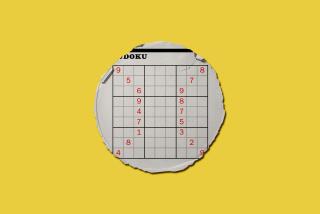Doctor has a sharp eye for crosswords
- Share via
What six-letter word describes the San Diego ophthalmologist who has quickly become one of the top New York Times crossword puzzle creators in the world?
Answer: Haight. As in Bruce Haight, a 63-year-old Poway grandfather who has had 20 puzzles published in the Times in the past four years, with 12 more waiting in the wings. He’s also had 20 puzzles published in the Los Angeles Times, with 5 in the pipeline.
Since January 2013, Haight has ranked among the top 10 crossword creators published in the prestigious New York paper, and he’s just getting started. Since he discovered the hobby in April 2012, he has churned out more than 300 puzzles in his spare time.
Will Shortz, the New York Times’ crossword editor, said Haight is a prolific producer with a lot of fresh ideas and clues and his puzzle “fill” (words) are getting better all the time.
Haight said crossword-building fills his downtime at work, challenges his intellect, entertains his patients and has introduced him to a wide circle of puzzle-loving friends who chat online and convene every year in New England. But even more important, crossword puzzles saved Haight’s life.
When he started creating puzzles four years ago, he became so obsessed he lost interest in food and sleep and rapidly lost 10 pounds. His wife, Kaiser neuro-oncologist Liz Spier, was so worried, she ordered an MRI scan that showed an early-stage kidney cancer. Left undiagnosed, like most kidney cancers are until symptoms appear, it might’ve killed him in five years.
“You could say I’m alive today because of it,” he said.
Yet for all his constructing prowess, Haight admits he’s not very good at solving the tricky word puzzles. An easy Monday or Tuesday Times crossword maybe, but definitely not the ultra-difficult Friday and Saturday grids. Wordsmithing isn’t his expertise, numerical grid-building is.
Haight was born with a knack for numbers and patterns and over the years has been both a competitive bridge player and backgammon champion, according to his proud parents, Jim and Joyce Haight. Snowbirds from Wisconsin, they’ve wintered since 1987 in Tierrasanta, where they’re avid golfers.
“Growing up, Bruce was smart as a whip,” said Joyce, a retired tax consultant. “But he was always more into science and numbers than words. I was the one in the family who like doing the crosswords.”
She and Jim, an insurance agent for 60 years, followed their son to San Diego after he moved from Madison, Wis., in 1978 to attend ophthalmology school. Four years later, he opened his practice, Grossmont Eye Center, in La Mesa.
He and his first wife raised two children, a 35-year-old daughter in Laguna Niguel and a 24-year-old son in Las Vegas, and have been active travelers, golfers and tennis players. While he enjoyed the occasional game of Sudoku, Haight said he only worked crossword puzzles once or twice a year.
Then a childhood friend — acclaimed puzzle-builder Peter A. Collins — suggested Haight give crossword construction a try. He downloaded an app on his iPad, came up with a puzzle idea and then asked for guidance from Collins, a high school math teacher in Michigan who has published 97 puzzles in the Times.
Haight’s first puzzle wasn’t accepted by Shortz. Nor were his next 37. Finally, he made a sale (the Times pays $360 for a daily puzzle and $1,200 for a Sunday grid) and his literary-themed debut crossword was published on Jan. 3, 2013.
“It took 39 tries to get accepted and that was the worst puzzle I ever made,” Haight said. “I think Will Shortz was feeling sorry for me because he’d rejected 38 in a row. It got the lowest rating of any puzzle I’ve ever seen, but I was still proud of it and I worked harder.”
Shortz, in a phone interview Thursday, admits that Haight’s skills have come a long way over the past few years, particularly in the areas of word fill and clues.
“In the beginning we had to spend a lot of time on his fills but now they’re a lot smoother,” Shortz said, adding, “Bruce has become a much better clue-writer over the past year. I used to have to change most of the clues he submitted. Now not so many. His clues now are fresh and on-target. He’s a pleasure to edit.”
On Dec. 4, Haight achieved his greatest milestone with the publication of his first Sunday crossword in the Times. The extra-large “Action Stars” puzzle featured film actors whose surnames — with the suffix “ed” — formed a past-tense verb, like “Sean Penned,” “James Garnered” and “Helen Hunted.”
Haight specializes in puzzles with grid art, where the black squares between the letter boxes are arranged in a recognizable pattern. He once created a puzzle with the likeness of Benjamin Franklin, another with fish swimming upstream, one with birds and another of juggling balls (one of his hobbies in college). His favorite, published in the Times on Feb. 17, 2015, featured a Scottish terrier.
But interesting grid art alone doesn’t make a sale. The Scotty dog puzzle, for example, featured dog breed words with multiple meanings (for example a poodle could be a dog, a haircut or a skirt). Shortz said his favorite Haight puzzle had a large black capital letter “I” in the middle, and many of the words that flowed up to it used that “I” as a word part, like “Adelph_” and “literat_.”
“That was really brilliant,” Shortz said.
Another of Haight’s specialties is grids with a minimum of letters. He recently submitted a puzzle that uses just six letters of the alphabet, he’s waiting for another to be published with seven letters, and on April 14, 2015, the Times published his grid built with eight.
“Above everything else, there’s Bruce’s feat of producing a pretty-clean grid using only eight different letters of the alphabet. Wow. I doff my hat,” Shortz wrote of that puzzle, in the online forum xwordinfo.com.
Of course, not every crossword gets such high praise. On another forum hosted by puzzle-solver Rex Parker, a reviewer gave Haight an “F” grade for the “musty clues” on a grid that ran last July featuring two-word phrases with the initials “S.T.” Haight said Shortz has often come to the defense of his constructors whose puzzles get “ripped to shreds” on Parker’s website.
Haight spends about 20 hours a week making crosswords. Each one takes about three to four hours to complete. He starts with a theme, lays out the grid, then uses software to find interesting words and phrases to fill in the blanks from a self-edited list of 300,000-words. The last step is writing the clues. Once the Times accepts a puzzle, Haight said it can take up to three years before it’s published.
When he was first starting out, Haight’s acceptance rate was slim, just 4 percent, but as he has improved in skill, it has risen to 15-20 percent. So far, he’s had puzzles published in the Times every day of the week except Saturday, which is always among the hardest puzzles of the week to solve.
“The Saturday puzzle in the New York Times is a dream,” he said.
Haight said his goal is to get 50 to 75 puzzles published in the Times, which he said would make him among the top 30 crossword constructors in the world. That won’t be easy.
“As I get better, so do other people around the world,” he said. “It’s twice as difficult now to get one published than it was three years ago.”
Crosswords haven’t just enriched Haight’s life, he said they’ve also been a boon to his business.
“I give out about a dozen crosswords a day to interested patients of mine,” he said. “Sometimes a patient will come in for an eye exam and I can’t figure out why they came back so soon and it turns out they just want another crossword I designed.”
pam.kragen@sduniontribune.com



